#wet-plate collodion process
Explore tagged Tumblr posts
Text
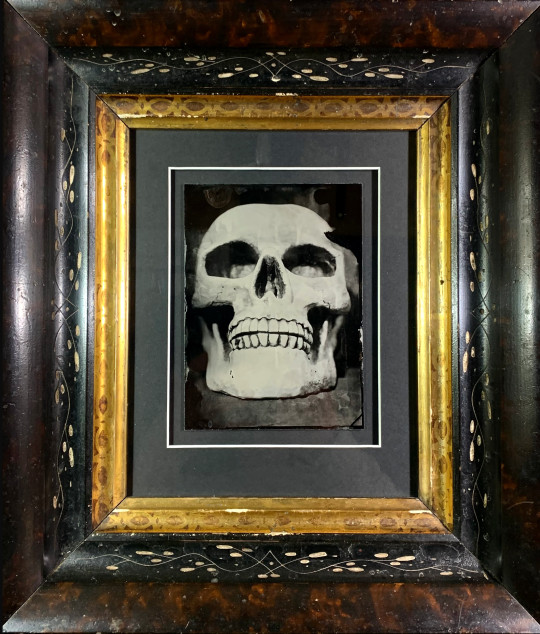
*Self Portrait from the Future* Tintype - One Kindred Spirit Vintage Frame
#tintype#wet plate collodion#skull#death#self portrait#photographers on tumblr#original photography#vintage#alternative processes#darkroom
81 notes
·
View notes
Text
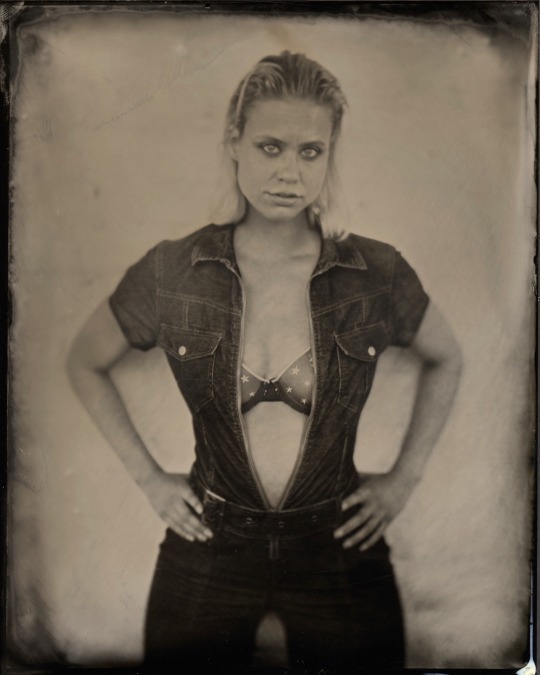
Anneke on tin.
13 notes
·
View notes
Text










Pablo Fanque's Fair is the project in the field of visual arts based on photography that combines historical and contemporary techniques in aspiration to present in images a beauty that is physically tangible. Motive force of Pablo Fanque's Fair is the wish to penetrate in magical realism of surrounding reality instead of meaningless routine. The project's creativity is inspired by the highest meanings of life: Beauty, Love and Peace.
The project's name was inspired by the line from the song of The Beatles “Being for the Benefit of Mr. Kite!” where John Lennon quotes the old circus poster. This name reflects the “fairground” diversity of genres and themes in the body of work, as well as the use of historical techniques and alternative photographic processes (namely oil pigment print, wet plate collodion), employment of antique cameras and lenses, implementation of manual techniques on tangible media.
#photography#art collective#photomagazine#culture#art#bnwphotography#medium format#analog photography#film photography
9 notes
·
View notes
Text





Today in 1839, Louis Daguerre announces his daguerreotype photographic process to the French Academy of Science. This is considered the first successful form of photography, available to the public. In collaboration with Nicéphore Niépce, Daguerre invented the technique in the 1830s. They discovered that a copper plate coated with silver iodine when exposed to light in a camera, fumed with mercury vapor and made permanent by a solution of common salt would produce a permanent photo. A great number of portraits were made in the mid-19th century by this technique. The daguerreotype photo process would be replaced by the wet collodion process around 1851.
#histoire#history#history in the making#history is awesome#history of science#history stuff#historyposting#today in history#history lesson#connecticut#history photos#photography#my photos#photoshoot#photooftheday#history will say they were best friends#history is all you left me#history lover#portrait#history has its eyes on you#history of music#usa#history repeats itself#history is fun#history today#history rant#history era#history aesthetic
2 notes
·
View notes
Text
Assignment 6 part 1; step 1:
Photo 1 link: https://www.lensculture.com/explore/award-winners/portrait-awards-2023?modal=johannes-schembs-the-winner-of-portrait-awards-2023
Photo 2 link: https://cairostudentphotography.weebly.com/uploads/6/8/3/7/68370099/dsc-0566.jpg
For this part, I chose a photo by the photographer Johannes Schembs and an image by the student Alia Abou Ahmed; both are photos from a photo series.


I chose these pictures because visually both are very similar, but after understanding them and reading about them, they are very different. Starting off, they are both under the same photography genre, which is portrait. Both of them are created in a very creative and unique way.
When I first saw these pictures, I thought they used the same technique, and after my research, I was right. They both used the double exposure tool. They overlaid two pictures together. For Johannes Schembs, he overlaid two pictures of two sisters together to make one picture. If you look closer, you can actually see that there are two people in the photo and not one. We can detect that because of the different clothe and because one of the sisters has a nose piercing and the other does not. As for Alia Abou Ahmed, she overlaid two pictures of herself, one wearing a mask and the other she doesn’t.
I think Schembs's usage of this technique was mainly to use the old process of collodion wet plate photography, but as for Abou Ahmed, it had a meaning.
Abou Ahmed used this technique to express the feeling of anxiety. She used herself because she feels anxious in stressful situations, and so she wanted to share with others how anxiety feels for her.
So, mainly they both used the same technique, photography genre, but for very different reasons; each had his own message or purpose. However, they are very creative, unique and visually appealing.
If there anything I would have done differently or improve is:
For Schembs I think it would be visibly easier if the two sisters had element that cam help differentiate them apart, as for Abou Ahmed I would suggest adding more elements that can point to anxiety for example words in the background like the word stress or something. Other than that I think that these two are great example of a creative and unique artwork.
2 notes
·
View notes
Text
Photographer research post #5: Rashod Taylor
Rashod Taylor is a contemporary photographer known for his compelling and thought-provoking work that often explores themes of identity, culture, and social issues. He is celebrated for capturing the nuanced experiences of Black communities, particularly in urban settings. Through his photography, Taylor delves into the intersections of race, class, and personal expression, offering a fresh and important perspective on the realities of contemporary life.
Taylor is especially keen to utilizing wet plate to create striking images that almost convey a smokey substance in appearance and work to really gravitate the viewer's attention to his subjects. He can do wet plate in a large format which he explains that he feels slows him down in his process to create a well composed photo. And I would agree that these photos are captivating to look at and really work to convey a strong personal message.
In addition to portrait photography, Taylor also works with street and environmental photography, capturing everyday life and the vibrant, diverse cultures that exist in urban environments. His work is marked by a keen sensitivity to light, composition, and color, which enhances the emotional impact of his images. Whether photographing individuals, communities, or scenes from the street, Taylor’s photographs reflect his deep connection to the subjects he portrays.
Taylor's photography extends beyond aesthetic concerns; his work often serves as a form of social commentary. By documenting lives that are too often overlooked or misrepresented, he challenges viewers to engage critically with issues such as systemic inequality, identity, and representation in media. His approach to storytelling is raw and authentic, offering a window into lives that are often ignored or misunderstood.
Rashod Taylor's My America is a deeply introspective photographic project that offers a unique and personal perspective on the American experience. Through his lens, Taylor captures the complexities of identity, race, and place, weaving a narrative that speaks not just to his own lived experiences but also to broader social and cultural issues. The project feels intensely personal, with each photograph conveying a deep emotional resonance. Taylor’s images serve as a mirror, reflecting the challenges and triumphs of Black life in America, but also the quiet moments that often go unnoticed. In this series, Taylor does not just document; he embodies the emotional weight of his subjects, offering a voice to individuals who may otherwise remain on the periphery of mainstream narratives. The intimate portraits he captures allow us to see the humanity behind the headlines and statistics.
Overall, Rashod Taylor is a photographer whose work continues to inspire and provoke, offering valuable insights into the lived experiences of Black individuals and communities, and challenging the status quo in the art of photography.
youtube
0 notes
Text
Daguerreotypes were invented in the 1830s and the wet plate collodion process was invented in 1851. Frustratingly there is very little information on the Internet about either the painting or the artist, though his French Wikipedia page talks about his mastery of perspective and architectural drawings. However, given how much photography had advanced by this time I would be extremely surprised if he didn't use it along with sketches from the balloon.
The artist is Victor Navlet and the painting is called “General View of Paris from a hot-air balloon” (1855)
35K notes
·
View notes
Text
"The Evolving Art and Science of Photography: From Digital Masterpieces"
Photography, often referred to as the art and science of capturing light, has evolved dramatically since its inception in the early 19th century. From its humble beginnings with daguerreotypes to the advanced digital cameras of today, photography has continually expanded the way we perceive and document the world around us.
A Brief History
The journey of photography began with the invention of the daguerreotype in 1839 by Louis Daguerre, which allowed for the first time the creation of permanent images. This early process involved exposing a silver-coated copper plate to light, producing a detailed and unique image. As technology progressed, so did the methods and materials used. In the mid-19th century, the wet plate collodion process introduced glass plates and required immediate development, while the introduction of roll film by George Eastman in 1888 made photography accessible to the masses with the Kodak camera.
The 20th century saw significant advancements with the development of color photography and the shift from film to digital formats. The advent of digital cameras and smartphones has made photography more democratized, allowing nearly everyone to capture high-quality images at any time.
The Art of Photography
Photography is not just a technical process; it is an art form that combines creativity, composition, and emotion. Photographers use a variety of techniques to convey their vision, such as framing, lighting, and perspective. The choice of subject matter, whether it’s a portrait, landscape, or abstract composition, also plays a crucial role in the artistic impact of a photograph.
Composition is one of the fundamental aspects of photography. Techniques such as the rule of thirds, leading lines, and symmetry help guide the viewer’s eye and create a more engaging image. Lighting is another critical element, influencing mood and highlighting textures and details. Natural light, studio lighting, and the interplay of shadows and highlights all contribute to the overall aesthetic of a photograph.
The Science Behind the Lens
While artistic skills are essential, understanding the technical aspects of photography is equally important. Modern cameras come with a myriad of settings that allow photographers to control exposure, aperture, and shutter speed.
Exposure refers to the amount of light that reaches the camera’s sensor or film, affecting the brightness of the image.
Aperture controls the size of the lens opening, which affects the depth of field—the range of distance within a photo that appears sharp.
Shutter Speed determines how long the camera’s shutter remains open, affecting how movement is captured in an image.
Digital sensors have replaced traditional film, offering greater flexibility and immediate feedback. These sensors capture light through millions of tiny cells, each corresponding to different colors, to produce high-resolution images. Advances in sensor technology and image processing software have further enhanced the quality and versatility of digital photography.
The Digital Revolution and Beyond
The rise of digital photography and smartphones has transformed how we capture and share images. Social media platforms and photo-sharing apps allow users to instantly disseminate their photos to a global audience, influencing trends and democratizing photography further.
Moreover, the integration of artificial intelligence and machine learning in photography has introduced features such as automatic scene recognition, advanced image editing tools, and enhanced low-light performance. These innovations continue to push the boundaries of what is possible in both capturing and enhancing images.
Conclusion
Photography remains a powerful medium for both personal expression and professional communication. It bridges the gap between art and science, allowing us to document and interpret our world in meaningful ways. As technology continues to advance, the potential for new creative and technical possibilities in photography is boundless, promising an exciting future for both aspiring and experienced photographers alike. Whether through the lens of a high-end camera or a smartphone, the essence of photography—capturing fleeting moments and turning them into enduring memories—remains timeless.
1 note
·
View note
Text
Collodion Magic Without the Mess
"The collodion photographic process, invented by Frederick Scott Archer in 1851, involves coating a glass or metal plate with collodion, sensitizing it with silver nitrate, and exposing it while still wet. The plate is then developed and fixed immediately using sodium thiosulfate or potassium cyanide. This rapid process, requiring a portable darkroom, yields high-resolution images with fine detail and a unique, ethereal quality." -- The Collodion Process
Imagine the collodion process, but now you’re doing it digitally—because who has time for a portable darkroom and chemicals that sound like they could melt your face off? Here’s how it goes:
Step one: You take your sleek, overpriced smartphone—because, of course, we’re all photographers now—and slap on a filter that makes your image look like it was dipped in vintage nostalgia and regret. The digital ether and alcohol mix right on your screen, without the stink or the mess.
Step two: Snap a shot of your subject—probably your cat, because cats don’t complain about how they look in photos. Watch as your screen turns that pristine image into something that looks like it’s been dragged through time, kicking and screaming.
Step three: Hit that develop button, which, in reality, is just a fancy way of saying, “Let the app do its magic.” Watch as it creates an image that’s part haunting Victorian portrait, part modern-day selfie nightmare.
Step four: Share it on social media, where it gets lost in the sea of everyone else’s attempts at being ironically retro. Your friends will comment with hearts and fire emojis, pretending they understand the artistry, but really they’re just hoping you’ll like their next post.
And there you have it: the digital collodion process. All the aesthetic, none of the hassle, and a whole lot of pretense.
0 notes
Text
WEEK 2: BRIEF HISTORY IN PHOTOGRAPHY
PART ONE:
Following this article, the blurred line between the authentic truth and the altered truth in photography lies within the birth of Adobe Photoshop in 1990. In history, photography has always been viewed as a ‘factual representation of the truth’ so much so that images can be used in legal matters, and to prove pretty much anything. The phrase known to most is ‘the camera never lies’ but in recent years, the altered truth of imagery has turned that phrase into ‘pics or it didn’t happen’ - the new modern extension.
People have grown to be questioning the practice of photography especially in more recent times where prominent coverage of faked imagery has been making the media. An example of this is in mid-June 2020, Fox News was accused of manipulating photographs of the protests during the uprise of the Black Lives Matter movement which included the formation of the Capitol Hill Autonomous Zone (CHAZ) in Seattle. People saw this as unethical and morally incorrect.
Personally, I think that this is one of the poorest things to do as a publisher. Using your power over an image to lie creates a hostile and bad reputation for the wider media/journalism industry. Everyone knows the saying a picture speaks 1000 words so by publishing this, the readers were only provided with false information and the words spoken from the image were full of misrepresentation and created a false sense of fear amongst a wider community.


Entering this post-truth era in journalism, conversations about altered photography are all based around the blurred line between truth and misrepresentation as I talked about in the paragraph above. In my own experience, seeing the photoshopped images of Trump have made me laugh. I’ve always known that they are fake but because he uploaded the one of him looking like Rocky to Twitter, that could have older or easily convinced users thinking that Trump has a 6 pack of abs and is ready to fight his way (literally) back to the White House. Even the photo on the right could be altered too because it looks slightly unnatural to me, as he doesn't look like this on TV during presidential broadcasts.
I think this form of photo manipulation is very comical, I am always going to support making someone so awfully powerful look silly on the internet, but I can also understand how it can stray from the truth and how photoshopped images can alter the authenticity of people's opinions and sway people between fact and fiction.

Bullet Points surrounding photo manipulation in the 19th Century. These techniques and examples highlight the early use of retouching, manipulation and editing techniques in photography's foundational years.
Talbot's invention laid the foundations for the salted paper print and calotype, introducing the photographic negative and positive.
The medium's restrictions prevented it from capturing reality as shown in nature.
The 1850s saw technological advancements increasing photography's capacity for accurate rendering.
The albumen print complemented the wet collodion glass plate, invented by Frederick Scott Archer (1813-57) in 1851. The wet collodion negative limited exposure times to mere seconds, allowing sharp and defined images.
Multiple prints could be made from a negative, but wet collodion negatives required on-site development with a portable darkroom.
The technique's insensitivity to blue light meant skies and seas couldn't be captured accurately together, forcing photographers to adapt.
PART TWO
The release of the kodak brownie cameras in 1900 was the first accessible camera known to be so flexible and accessible the world had seen thus far. The camera was $1 USD and was marketed towards children and adults emphasising the easy use and accessibility of it. Kodak offered to process, print photos, and reload the camera at their factory. In 1917, two cousins from Yorkshire, Iris and Alice, took photographs on these Brownie cameras depicting themselves as fairies. In 1919, the photographs reached the public and gained interest from spiritualist Sir Arthur Conan Doyle, and he requested more images from the girls to test their authenticity. After the second lot of images, any doubts he had were overcome – he believed the images. Early photo staging and manipulation was underway! The girls used cardboard cutouts and hatpins for the images, spirit photography was now very well-known and was also known to be staged. During the World War and the Civil War, spirit photography gained a massive following as people needed a belief to hold onto tho that their loved ones had actually lived on. By the 1920s photographs were deemed essential in daily lives and households, recording family memories and experiences. The Kodak Brownie introduced a movement of ‘snapshot’ images, and they were seen as less formal due to the spontaneous nature of the image and the portability of the Brownie Cameras. It over looked controlled compositions and subjects we can still see snap shot style of photography today through the likes of casual posting on social media!
Snapshot albums were black and white images framed and placed onto a black page. Although colour photography was already in motion, this was probably more financially accessible for the Kodak Brownie users. When people bring up the topic of altered photography, the use of black and white imagery is debated around realism and how reliable the image is because staged images are so much easier to get away with as I learn’t about the cousins with the fairy images. The absence of colour photography led to the popularity of hand-coloring and tinting, but many h images often appeared garish and unnatural, contrary to the desired effect of colored photography. Airbrushing was seen as an early form of manipulation and there was a strong desire to make areality of colour photography for greater realism.
The introduction of coloured photography was introduced through the Lumèire Autochrome that was released in 1907. In 1935, Kodachrome was released and replaced Lumèire. Over time, the advancements in colour photography grew significantly over time and the small advancements each film made were highly praised as it was so fast-moving. The changing colours and fading of color's over time always had skeptical viewers questioning if the image was real and if it was manipulated but that is just the nature of coloured ink versus the sun!
Growing more into colored photographic practices, people then started touching up old black and white images and wanting to ‘humanize’ the past. But some critics then argued that this goes against the truth of the origin of the black and white image and alters the initial photograph and the context in which it was taken in.
In the twentieth century when documentary photography become a key method of recording worldwide events, there were still manipulation practices despite the understanding that documentative work should be untouched and natural. The use of manipulation and postproduction editing techniques was becoming more comfortable and accessible to the world.
Some examples of these images are the Lunch Atop a Skyscarper (1932), presented as a candid shot of construction workers having lunch 300 meters above New York City in the New York Herald Tribune, it was later revealed to be orchestrated to advertise the Rockefeller Center, with workers encouraged to pose.
World War II Photography (1939-45), photography captured critical moments, essential for understanding conflict. One image (Raising the Flag on Iwo Jima 1945) depicted six U.S. marines raising the flag on Mount Suribachi, Iwo Jima. It became a defining image of the war, winning the 1945 Pulitzer Prize for Photography. It also faced claims of staging, though Rosenthal denied them. The photograph shows a second flag raising, not the original capture, adding to the distrust surrounding photography.
Distrust in Photography because of manipulation techniques existed to alter impressions and aesthetics which then completely altered the context of the image. It came to a rise after Yevgeny Khaldei’s (1917-97) photograph, ‘Raising a Flag over the Reichstag’ (1945) was staged to symbolize Soviet victory over Nazis during the Battle of Berlin. The image utilized soldiers to re-enact the action of raising the Soviet flag. This was done by manipulation in the darkroom to add smoke for dramatic effect using another negative. Following on from this, photographers used editing to create aesthetically pleasing compositions enhancing their work visually but this could also raise the argument of taking the context out of the image. Personally, I am a big advocate for making work that you love and want to look at and be proud of for a long time so I understand enhancing the image to become more of what you were looking for but on the flip side, using manipulation to create almost a completely new and different image for the professional use/publishing is quite immoral and unethical to me.
Interpretation in photography is all up to the opinion of the viewer. It is all subjective and the subjective nature of the photographer influences how a photograph is framed and interpreted. Overall photography involves a selection and an interpretation of the world Frank webster said this happens in 2 aspects. The photographer's role is choosing to display an image and the second role, the viewers role, interprets (reads) the photograph, decoding its meaning through the photographer's use of context.
Adobe Photoshop Release (1990):
Basic compared to today's standards, but enabled easy manipulation of photos.
Features included cloning, removing sections, and adjusting opaqueness, hue, and saturation.
Affordable and accessible, encouraging wider use.
Photography's status as a truthful medium became questionable post-Photoshop.
Numerous pre-Photoshop examples already demonstrated the potential for manipulation and editing.
Photoshop could be used as propaganda both commercially and colonially to implement a new truth. Commercially, it could be used to influence consumer perceptions and colonially they used Photoshop to sway support to dominant narratives. And some spiritual people used it to convince others that magic eg. Fairies, witches etc were real.
0 notes
Text
During the 1460s, advancements in technology were reshaping the way people captured and preserved memories. The printing press, developed by Johannes Gutenberg in the mid-15th century, allowed for mass production of books and images, including photographs. As a result, photographs became a popular means of preserving moments in time and were sought after by the wealthy elite.
However, the process of taking and developing photographs was a lengthy and complicated one, leading to a lag between the moment and the final product. This caused frustration and disappointment for those who wanted instant gratification, especially when compared to the immediacy of paintings and sketches.
One of the main reasons for the lag in photograph development during this time was the use of wet-plate collodion, a method introduced in the 1850s. This process involved coating a glass plate with a syrupy solution, sensitizing it with silver nitrate, and then exposing it to light. The plate had to be developed and fixed immediately, requiring a makeshift darkroom and skilled handling. The whole process was time-consuming and required a lot of skill and patience, often resulting in images with flaws or imperfections.
Additionally, the materials used for photography in the 1460s were expensive and not widely available. This meant that there were only a limited number of skilled photographers and makeshift darkrooms, causing further delays in the development of photographs.
Another reason for the lag in photographs during this period was the lack of suitable subjects. In the 1460s, photography was still a novelty, and many people were not used to the idea of posing for a photograph. This reluctance, along with the lengthy process, made it challenging to find willing subjects and capture spontaneous moments. As a result, most photographs were posed and lacked the natural and candid feeling of paintings and sketches.
Moreover, photographs were often seen as a luxury and were mostly reserved for the wealthy. As a result, there was not much demand for them, with most people opting for paintings or sketches as a more accessible and affordable means of capturing memories.
In conclusion, during the 1460s, photographs were overburdened for lags due to the complicated and time-consuming process of developing them, the lack of availability of materials and skilled photographers, and the reluctance of subjects to participate. As technology continued to advance, these issues would eventually be resolved, making photography more accessible and immediate for future generations.
0 notes
Text

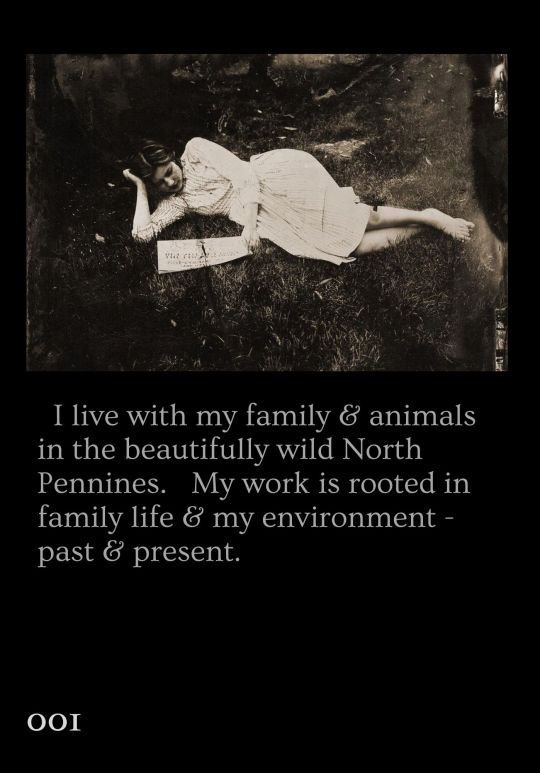
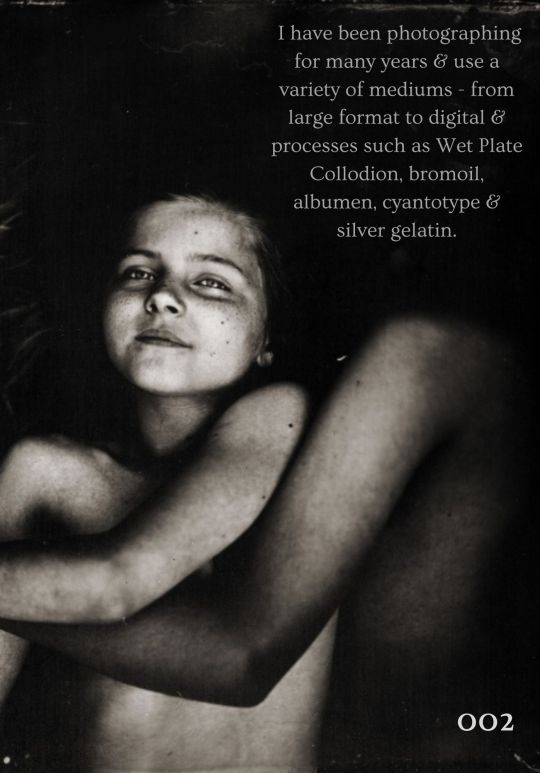

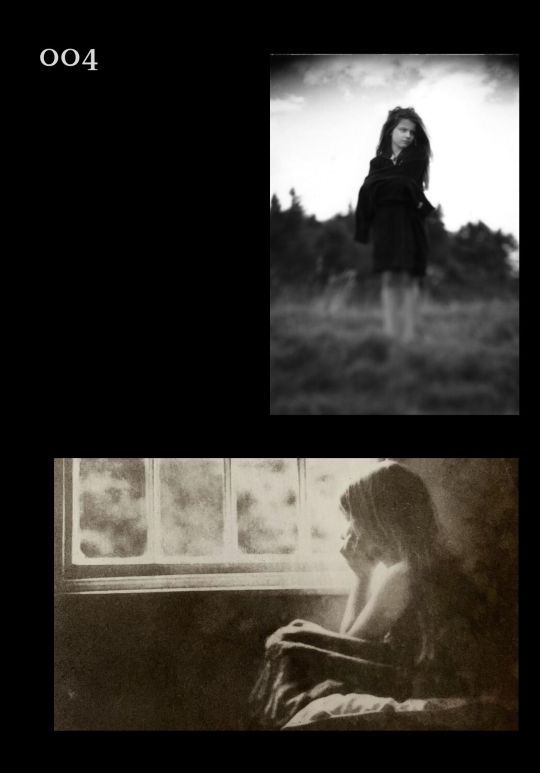
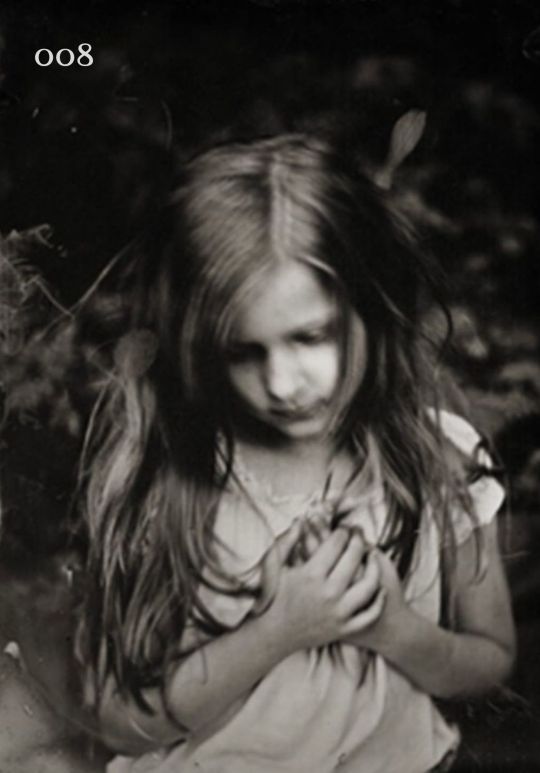
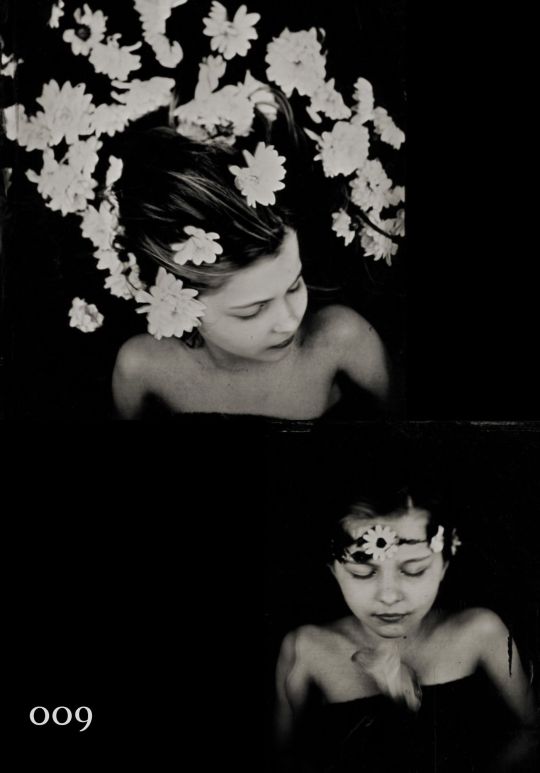


I live with my family & animals in the beautifully wild North Pennines. My work is rooted in family life & my environment - past & present. I have been photographing for many years & use a variety of mediums - from large format to digital & processes such as Wet Plate Collodion, bromoil, albumen, cyantotype & silver gelatin.
My work has been exhibited & published worldwide - including Japan, U.S. U.K, Bulgaria, Iran & China & is held in many private collections from individual collectors (U.S, U.K, Europe, Japan) to museums & galleries - including the Fox Talbot Museum (UK) & the Centre for Fine Art Photography (U.S) & Charlet Gallery (Paris).
#Deborah parkin#photography#wet plate collodion#bromoil#silver gelatin#women photographers#original photographers
30 notes
·
View notes
Text
Exploring the Techniques, History, and Legacy of Wet Plate Photography
Exploring the Techniques, History, and Legacy of Wet Plate Photography
Wet plate photography, a technique that flourished in the mid-19th century, remains a fascinating chapter in the history of photography, captivating modern enthusiasts with its unique blend of artistry, chemistry, and historical significance. This article delves into the intricate techniques, rich history, and enduring legacy of wet plate photography, offering insights into its resurgence in contemporary artistic practice.
Historical Context
Wet plate photography, introduced in the 1850s, rapidly became the dominant form of photography due to its ability to produce detailed and reproducible images. The process involves coating a glass or metal plate with a collodion solution, sensitizing it in a bath of silver nitrate, exposing it while wet, and developing it—all within a span of about fifteen minutes. This method was a significant advancement over the daguerreotype and calotype processes, offering shorter exposure times and the ability to create multiple copies from a single negative.
Techniques and Innovations
The core of wet plate photography lies in its intricate technique, which demands precision, timing, and an understanding of chemical interactions. The process can be divided into several key steps:
Preparation of the Plate: The photographer coats a clean glass or metal plate with collodion, a viscous solution that forms a thin, light-sensitive layer when dipped in a silver nitrate solution.
Sensitization: The collodion-coated plate is submerged in a silver nitrate bath, making it sensitive to light.
Exposure: The sensitized plate is placed in a camera and exposed to light. Exposure times vary depending on light conditions and the subject's nature.
Development: After exposure, the plate is developed using a solution that reduces the exposed silver ions to metallic silver, forming the image.
Fixing and Washing: The plate is then fixed to remove unexposed silver and washed to eliminate any remaining chemicals.
Modern practitioners often adopt USP-grade collodion for convenience, emphasizing the importance of prompt development and proper chemical preparation to achieve the best results. The process has been refined over the years, with safety and efficiency in mind, challenging and correcting many myths surrounding the practice.
Legacy and Revival
The legacy of wet plate photography is evident in its unique aesthetic, characterized by a timeless quality, fine detail, and a depth that digital photography struggles to replicate. The process not only offers a tangible connection to the past but also serves as a counterpoint to the ephemeral nature of modern digital images, emphasizing craftsmanship, patience, and the physicality of the photographic medium.
In recent years, there has been a resurgence of interest in wet plate photography among artists and photographers seeking to explore its creative potential and historical significance. Workshops, online forums, and exhibitions have fostered a community of practitioners who are not only preserving but also innovating within this traditional technique, blending historical methods with contemporary themes and subjects.
Conclusion
Wet plate photography represents a fascinating intersection of art, science, and history. Its enduring appeal lies in the hands-on process, the distinct visual qualities of the images, and its capacity to connect us with the pioneering days of photography. As modern photographers continue to explore and reinterpret this historic technique, wet plate photography's legacy is both preserved and reinvigorated, highlighting the ongoing dialogue between past and present in the photographic arts. More of my artwork can be found at https://hopeaajavaloa.fi
1 note
·
View note
Text
Class experience-Wet Collodion Process
The Wet Collodion process was mentioned in class and it's a process for developing the exposure of pictures. This process was originally introduced in 1851 by Fredrick Scott Archer. This process was one used in the early stages of photography. The wet collodion process used a piece of glass placed in a darkroom. Then it would get coated with collodion and then made light-sensitive with further chemicals. Before the plate could dry, it would be placed in the camera and exposed. Each photo had to be not only coated, but sensitized, exposed, and developed in no longer than a 15 minute interval. A combination of chemicals would be poured on a thin piece of glass under a red light which created the haiide substance. Once washed and dried it was coated with a protective varnish. This was a very tedious process and with technological advancements it has been modified to be easier and quicker.
For example, dry plate has made for an easier and quicker option. It's very similar to the wet process, but it calls for shorter preparation because the development doesn't have to be done all at once. Briefly mentioning this process, it gives a look similar to wet plate being its orthochromatic and has halonation (Gibbons). It involved using a light sensitive gelatin emulsion coat on glass photographic plates (Gibbons). As well for allowing them to dry prior to use.
George Eastman Museum, "The Collodion process," in Smarthistory, May 5, 2019, accessed February 4, 2024, https://smarthistory.org/the-collodion-5-of-12/.
https://www.nfsa.gov.au/preservation/preservation-glossary/dry-plate-photographic-process#:~:text=The%20Gelatin%20or%20Dry%20Plate,to%20dry%20prior%20to%20use.
1 note
·
View note

